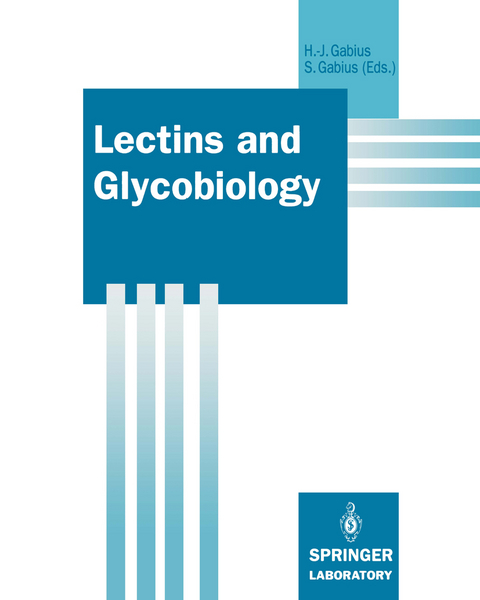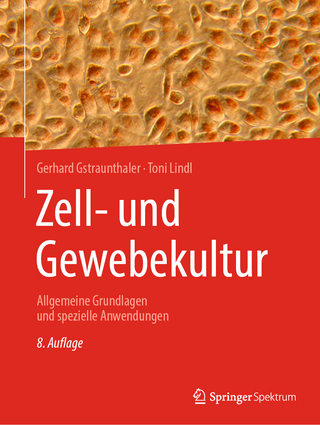
Lectins and Glycobiology
Springer Berlin (Verlag)
978-3-642-77946-6 (ISBN)
Hans-Joachim Gabius obtained his Ph.D. in 1982 at the Max-Planck-Institute for Experimental Medicine in Göttingen. After doing post-doctoral research from 1984-1985 in the group of S. H. Barondes at the UC San Diego, he was appointed first as assistant professor for biochemistry at the Max-Planck-Institute for Experimental Medicine in Göttingen (1987) and then as associate professor for pharmaceutical chemistry atthe University of Marburg (1991). Since 1993 he is heading the Institute for Physiological Chemistry, Faculty of Veterinary Medicine at the University of Munich. Prof. Gabius received numerous research awards including the Otto-Hahn-Medal (1983), the Award of the Dr. Carl-Duisberg-Foundation (1988) and the Award of the Paul-Martini-Foundation (1990). His research interests are focused on chemical, biophysical and biochemical analysis of protein - carbohydrate interactions with biomedical relevance, such as the development of glycoscientific strategies for tumor diagnosis and therapy and the elucidation of functions of mammalian lectins. His research led to a prominent placement in the ISI ranking of highly cited papers in 1998.
1 Lectins: Insights into the State of Knowledge by Literature Searches.- Chemical Synthesis of Lectin Ligands.- 2 Synthetic Ligands for Lectins.- 3 Sugar-Polyacrylamide Conjugates as Probes for Cell Lectins.- Purification and Characterization of Lectins.- 4 Isolation of Plant Lectins.- 5 A General Procedure for the Purification of Fimbrial Lectins from Escherichia coli.- 6 Isolation, Detection, and Ligand Binding Specificity of a Lectin Uniquely Found in Rat Kupffer Cells.- 7 Galaptin: Isolation, Electrophoretic Analysis, Peptide Preparation for Sequencing and Carbohydrate-Binding Site Specificity.- 8 Determination of Carbohydrate Specificity in Solid-Phase Assays.- 9 Analysis of Isoelectric Variants of Carbohydrate-Binding Protein 35.- 10 Chemical Modification of Lectins by Group-Specific Reagents.- Biophysical Methods for the Characterization of Lectin-Ligand Interactions.- 11 Study of Oligosaccharide-Lectin Interaction by Various Nuclear Magnetic Resonance (NMR) Techniques and Computational Methods.- 12 Lectin-Glycoconjugate Cross-Linking Interactions.- 13 Lectins as Analytical Probes to Define the Physical Characteristics of Binding Events.- Lectins as Tools for the Characterization of Glycoconjugates.- 14 Glycoprotein-Lectin-Immunosorbent Assay (GLIA).- 15 Use of Lectins in Quantification and Characterization of Soluble Glycoproteins.- 16 Lectins as Indicators of Disease-Associated Glycoforms.- 17 Viral Lectins for the Detection of 9-O-Acetylated Sialic Acid on Glycoproteins and Glycolipids.- 18 Affinoblotting Detection of the Glycoprotein Ligands of the Endogenous Cerebellar Soluble Lectin CSL and of Concanavalin A.- Determination of Expression of Lectins and Their Ligands.- 19 An Enzyme Immunoassay (EIA) for a Human Endogenous ?-Galactoside-Binding Lectin.- 20Analysis of Lectin Expression by Immunoblotting.- 21 Application of Immuno- and Affinocytochemistry to the Detection of an Endogenous ?-Galactoside-Specific 14 kDa Lectin and Its Ligands.- Lectins and Neoglycoconjugates in Histochemical and Cytochemical Analysis.- 22 Tissue Lectins in Histopathology - Markers in Search of Their Physiological Ligands.- 23 Lectin Cytochemistry Using Colloidal Gold Methodology.- 24 Neoglycoprotein-Gold Complexes as a Tool in the Study of Carbohydrate-Specific Binding Proteins.- 25 Lectins and Neoglycoproteins - Attractive Molecules to Study Glycoconjugates and Accessible Sugar-Binding Sites of Lower Vertebrates Histochemically.- 26 In Situ Microdensitometry of Neoglycoprotein Staining: Detection of Tissue-Site Specific Patterns of Endogenous Lectin Expression.- 27 Lectin and Neoglycoprotein Binding to Cells.- 28 Use of Lectins for the Phenotypic Characterization of Cultured Cell Monolayers.- 29 The Use of Lectins in the Purification of Cellular Subpopulations.- 30 Lectin-Binding Properties of Extracellular Matrix in the Chick Oral Membrane.- 31 Biodistribution of Radioactive Lectins.- 32 Lectin Interactions with Intestinal Epithelial Cells and Their Potential for Drug Delivery.- 33 Neoglycoprotein-Liposome Conjugates for Studies of Membrane Lectins.- Lectins and Biosignaling.- 34 Effects of Lectins on Adenylylation and Phosphorylation of Plasma Membrane Proteins.- 35 Lectin-Induced Alterations in the Level of Phospholipids, Inositol Phosphates, and Phosphoproteins.- 36 Measurement of Intracellular Calcium Levels by Flow Cytometry Following Treatment of Murine Macrophage/Monocytes with Mistletoe Lectin.- 37 Measurement of Lectin-Induced Superoxide Release from Human Neutrophils.- 38 Isolation of Lymphocytes and Accessory Cells forAssays of Mitogenicity.- 39 Determination of Lectin-Mediated Augmentation of Natural Killer Cell-Mediated Cytotoxicity.- 40 Effects of Pseudomonas aeruginosa PA-I and PA-II Lectins on Tumoral Cells.- 41 Determination of Lectin-Dependent Alterations of Cellular Parameters by Immunophenotyping During Adjuvant Lectin Application.- 42 Lectin-Dependent Alteration in Availability of Nutrients in Serum and Erythrocytes.- Lectins and Cell Adhesion.- 43 Bacterial Adhesion to Immobilized Carbohydrates.- 44 Quantitative Micro-Adhesion Assay on Polystyrene Matrices.- 45 Lectin-Mediated Binding Activities of Bradyrhizobium japonicum.- 46 Identifying a Role for Carbohydrate Recognition in Regulating Neuronal Architecture.- 47 Identifying Cell-Cell Adhesion-Inhibitory Antibodies to Cell Surface Proteins Using Divalent Primary and Monovalent Secondary Antibodies - a Method Developed Using Cellular Slime Molds.- 48 A Modified Capillary Method for Measuring Bacterial Chemotaxis.- Molecular Genetics of Lectins.- 49 Cloning Lectin Genes.- 50 Cell-Free Synthesis of Lectins.- 51 cDNA Cloning and Expression of Plant Lectins from the Legume Family.- 52 Production of Intact Recombinant Lectins in Escherichia coli.- 53 Construction of Mutant Lectin Genes by Oligonucleotide-Directed Mutagenesis and Their Expression in Escherichia coli.- 54 Mammalian Lectin as Transforming Growth Factor.- 55 Identification and Expression of a Protozoan Invasion Factor: Penetrin, the Heparin-Binding Protein from Trypanosoma cruzi.
| Erscheint lt. Verlag | 16.12.2011 |
|---|---|
| Reihe/Serie | Springer Lab Manuals |
| Zusatzinfo | XX, 521 p. |
| Verlagsort | Berlin |
| Sprache | englisch |
| Maße | 193 x 242 mm |
| Gewicht | 994 g |
| Themenwelt | Naturwissenschaften ► Biologie ► Mikrobiologie / Immunologie |
| Naturwissenschaften ► Biologie ► Zellbiologie | |
| Schlagworte | Adhäsion • Adhesion • biochemistry • biosignalling • Biosignalübertragung • cell rcecognition • cellular processes • glycoprotein • Glycoproteine • glycoproteinoc • Lectins • Lektine • Oligosaccharid • Zellerkennung |
| ISBN-10 | 3-642-77946-8 / 3642779468 |
| ISBN-13 | 978-3-642-77946-6 / 9783642779466 |
| Zustand | Neuware |
| Haben Sie eine Frage zum Produkt? |
aus dem Bereich


